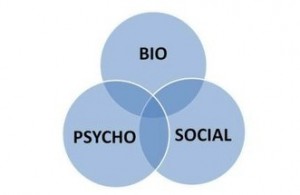Solving the Biopsychosocial Puzzle
By Nicole Murgia
In her essay “Science, Sex, and Good Sense: Why Women Are Underrepresented in Some Areas of Science and Math”, Diane F. Halpern uses the biopsychosocial approach to describe the different contributing factors that lead to the possible underrepresentation of women in the STEM fields. Last year in my psychology class, my teacher spent a lot of time on explaining the biopsychosocial approach. The biopsychosocial approach is often depicted as a Venn Diagram to explain how biological, psychological, and social issues can mesh together to create one thing. In Halpern’s case, she uses the approach to explain how genetic predispositions and brain development (biological), thoughts and behaviors (psychological), and experiences and environments (social) can all come together to solve the puzzle of why women are seemingly underrepresented in the STEM fields.
Biological. This focuses mainly on the different cognitive abilities between males and females. Halpern points out that mental rotation task abilities are more prominent in males while visual spatial task abilities are more common in females (Halpern 123). While both of these skills are helpful in the scientific field, some people hold the predisposition that the skills that involve mental rotational tasks are more necessary to have than spatial ability tasks when it comes to subject fields such as engineering, computer science, physics, etc. (Halpern 123). However, that is not the case. Spatial task abilities are just as important. This leads us to the next factor in our biopsychosocial approach.
Psychological. As stated in the biological section, men and women to tend to have different strengths when it comes to cognitive abilities. When made aware of this difference, men and women will acquire the mindsets that they are only good at certain tasks and cannot stray from that norm (Halpern 127). This is known as a “stereotype threat” (Halpern 127). An example of this threat in action would be if girls were made aware of the fact that boys tend to do better on the upcoming standardized test, they would do more poorly than boys because of the predisposed mindset, not because of their lack of ability (Halpern 127).
Social. In relation to the psychological factor, the social factor of the biopsychosocial approach is prevalent because of predispositions. The example used by Halpern has to do with the expected gender roles of women. Women are expected to have a family, and then be the primary caregivers. Because of this, many women stray away from the STEM field because of how time consuming it is. Society makes it seem unacceptable for women to choose success in their career over family life (Halpern 129). When women do choose to do both, they experience pressures that tell them that taking maternal leave is not acceptable, and that they have to choose one or the other: a career or family life (Halpern 129).
Halpern’s biopsychosocial approach correlates with my beliefs regarding the underrepresentation of women in the STEM fields. It is not just one factor that is the cause for this, it is the combination of multiple. When looking at the biological, psychological, and societal pressures that women experience, it is more understandable to to see why women are underrepresented in the field. Once the pieces of the biopsychosocial puzzle are put together, it is clear what the picture depicts; together, the different approaches show the reasoning behind the underrepresentation of women In science.
